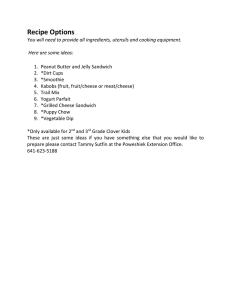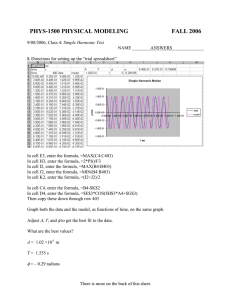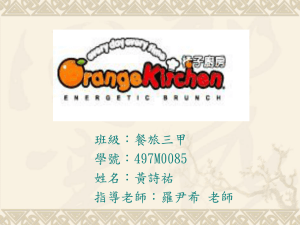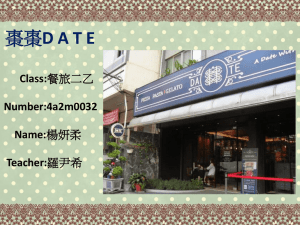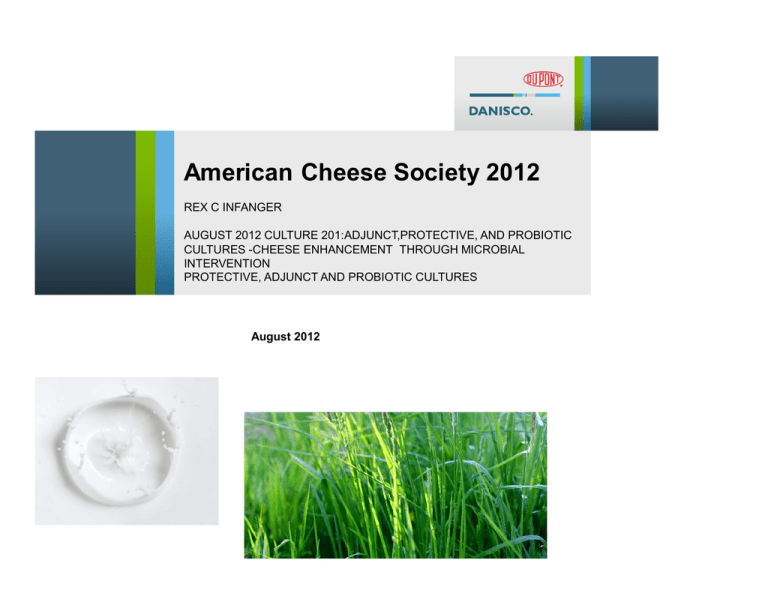
American Cheese Society 2012
REX C INFANGER
AUGUST 2012 CULTURE 201:ADJUNCT,PROTECTIVE, AND PROBIOTIC
CULTURES -CHEESE ENHANCEMENT THROUGH MICROBIAL
INTERVENTION
PROTECTIVE, ADJUNCT AND PROBIOTIC CULTURES
August 2012
Today’s Challenges in the Food Industry
The journey towards 2050
Consumer trends
Food Safety
Pathogen scare
Taste & freshness
Chemical scare
Health & Wellness
Functional foods
Natural/organic
Low salt/sugar
Sustainability
Product origin
Production methods
Recyclability &
waste reduction
Rise in natural, environmentally neutral technologies
and increased attention on food waste
Regulatory
Tighter regulations
on health claims &
microorganisms
impact
Agricultural
changes
New food pathogens
Animal husbandry
Demographics
Children, Women,
Elderly
Emerging countries
S o c I a l and p o l I t I c a l t r e n d s
Challenges
Foodborne illness (USA): 76 million sick, 325,000
hospitalized, 5,000 die per year.
Approximately 25% of the world’s food supply is
discarded every year due to microbial spoilage.
Huge economic impact.
The food industry desires alternatives to chemical
preservatives.
Challenge: improve microbial safety and quality of the
food supply.
Figures about Dairy Waste
40 to 65% of dairy waste is generated by households in
industrialized regions
Source: Global food losses and food waste - FAO 2011
Dairy Waste - Consumer Insight
Half of the consumers declare they experienced
spoilage in their dairy products at home
Moldy
35%
No spoilage
50%
Yeasty
5%
Both
10%
Source: Danisco global survey 2011
Base: 426 respondents, informed consumers
© Danisco 2011
Increased Scrutiny of Food Borne Diseases
C1 in 6 Americans (or 48
million people) get sick,
128,000 are hospitalized,
and 3,000 die of foodborne
diseases.
and
Emergence of new and
more virulent strains :
Salmonella heidelberg,
E.coli O104:H4.
Dairy Waste - Consumer Insight
% respondents
Impact on repurchase rate
100%
90%
80%
70%
60%
50%
40%
30%
20%
10%
0%
38
63
28
23
21
20
17
13
72
77
79
80
83
88
Milk
Yogurt
Quark/fresh
cheese
Spreads
Sour cream
Yogurt drinks Cottage
cheese
Will repurchase
Source: Danisco survey 2011
© Danisco 2011
Will not repurchase
Food Protection How do we Define It
FOOD PROTECTION
FOOD PRESERVATION
Maintenance of
organoleptic quality of
food by preventing
chemical (e.g. oxidation)
and microbial spoilage
Reduction of food waste
HOLDBAC® YM
FOOD SAFETY
Minimizing of pathogen
risks caused by
bacterial infections
throughout shelf life
Protection of human health
Food Preservation
Multiple hurdles to achieve spoilage control
Increasing shelf life
Sensory breakdown
CFU: 106
Inhibiting
Moisture
pH
Temp. Antimicrobials
Time
Killing
Factors Influencing Growth
FORMULA
INGREDIENTS
REFRIG
STORAGE
pH
HURDLE
TECHNOLOGY
MOISTURE
HEAT
MODIFIED
ATM.
MICROBIAL
INTERACTION
Live Cultures: Mechanisms of
Activity
Peptides
(Bacteriocins)
R-COOH
Metabolite
Production
R-COOR-COOH
R-COOR-COOH
R-COO-
Other
Molecules
Fermentates
Biomass
Production
Organic
Acids
Active Cultures
Live
Protective
Cultures
R-COOH
R-COO-
Microbial Fermentation
lactoperoxidase
fatty
acids
diacetyl
acetaldehyde
reuterin/
other compounds
of low molecular
mass
lactic
acid
acetic and
propionic
acid
Hydrogen
peroxide
carbon
dioxide
bacteriocins
These substances are
naturally occurring
antimicrobials which by
themselves or in combination
are highly effective against
spoilage and pathogenic
microorganisms.
Mode of Action: Organic Acids
H+
OHH+
Normal Cell State:
• DpHin-out = Molecular Transport
• DH+in-out = Energy Generation
H+
OH-
OH-
H+
Organic Acid Addition:
1. Lipophilic Properties
è Cellular Membrane Penetration
R-COO- H+
H+
OHH+
H+
OH-
OH-
H+
H+
H+
OHOH +R-COO
R-COO-H
OH- H+
H+
H+
R-COOH
R-COO-
2. Proton Delivery
• No DpHin-out = Reduced Transport
• No DH+in-out = No Energy Generation
ð Starvation
R-COOH
H+
R-COO-
H+
No Growth
=
BACTERIOSTATIC
FUNCTIONALITY
13
Mode of Action: Organic Acids
Percentage undissociated at
pH:
Mol wt.
pKa
5.0
6.0
7.0
Acetic
acid
60.1
4.76
35
5.2
0.55
Propioni
c acid
70.1
4.87
43
6.9
0.74
Lactic
acid
90.1
2.74
0.5
0.06
0.01
ü “Antimicrobial activity”: acetic ≥ propionic > lactic
Potential Advantages of Protective
Cultures
Shelf life protection against normal yeast and mold spoilage
Protection against mold spoilage due to temperature abuse
Longer fermentation time may enhance protection
Reduced fat content may enhance protection – Sour Cream
Protection against different mold species at relatively high
contamination levels
Little or no effect on flavor
No adverse effect on pH during storage
Protection against gas formation caused by heterofermentative
lactobacilli – Fresh Cheese
Functions of Cultures
Acid Production
o
Fast Acid Strains will coagulate milk in 18 hours at 69.8 F
Flavor
Acid production of lactic oxaloacetic, actetic, pryruvic, and
proprionic
Glycolitic pathway produces diacetyl
Proteolytic pathway produces ammonia, acetaldehyde,
ketones and esters
Lipolytic pathway produces free fatty acids
Syneresis (Moisture Loss)
Protein Agglomeration (Curd Formation)
Gas Production (Eye Formation & Flavor)
Culture Growth Stages
Lag Phase
Growth Phase
Logarithmic Phase
Stationary Phase
Death
o
Mesophilic Cultures (52-104 F)
Lactococcus lactis ssp. Cremoris (Streptococcus)
Lactococcus lactis ssp. lactis
Lactococcus lactis ssp. lactis,diacetylactis (taxonomically not recognized)
Leuconostoc mesenteroides ssp. cremoris (homofermentative acid production)
Thermophilic Cultures (86-122 F)
o
Streptococcus thermophilus
Lactobacillus delbrueckii ssp. bulgaricus
Lactobacillus helveticus
Propionibacterium shemanii
What are protective cultures?
Definition
Protective cultures are:
Bacterial species from food –
GRAS status
Specifically selected for ability to
control unwanted microorganisms
Selected for no adverse effect on
sensory quality
Used as viable (live) cultures
Increasing shelf life
Static
Moisture
pH
Temp.
Time
Antimicrobials
Cidal
Food Preservation
Multiple parameters influence inhibition
Storage
conditions
Fermentation
Process/Culture
Contamination level
Inhibition
Potential
Type of
spoilage
organisms
Protective cultures - why do they work?
Competitive
exclusion
Organic
acids
Other
natural
metabolites
Protective cultures
HOLDBAC® Cultures for an All-Natural Positioning
The Perception from Consumers
ENRICHED
Products
NATURAL, HEALTHY
Products
CONTAINS
Vitamins
Omega 3
Probiotics
®
HOLDBAC
Only Natural
Ingredients
ARTIFICIAL
PRODUCTS
NATURAL
PRODUCTS
No additives, preservatives
No artificial colours /
sweeteners / flavours
Cholesterol free
Fat free
STRIPPED
Products
Allergy free
DOESN’T
CONTAIN
Source: Lindberg survey- Focus groups with 91 end-consumers – Nov 2010/Jan 2011
© Danisco 2011
’LESS HARM’
Products
HOLDBAC® Cultures
A natural way to protect dairy foods
Patented live cultures
Unique properties - control the growth
of unwanted microorganisms
throughout shelf life
Isolated from food –GRAS organisms
No additional labelling requirements in
cultured products.
Products
Composition
HOLDBAC® YM-B
FRO & LYO
Lb. rhamnosus
P. freudenreichii subsp. shermanii
HOLDBAC® YM-C
FRO & LYO
Lb. paracasei
P.freudenreichii subsp. shermanii
HOLDBAC® YM Scope of activity
YM-C
YM-B and YMC
YM-B
CANNOT turn bad quality raw ingredients into good products
CANNOT replace Good Manufacturing Practice!
Natural
HOLDBAC® YM – do they actually work?
Control
Yeast
Control
HOLDBAC™ YM-C
HOLDBAC™ YM-B
HOLDBAC™ YM-C
HOLDBAC™ YM-B
Mold
HOLDBAC™ YM dosage: 10 DCU / 100 liter milk
Reducing waste and returns
- extend shelf-life/minimize fluctuations
1.00E+08
Yogurt challenge study - yeast
1.00E+07
Typical level for
sensory spoilage
Yeast cells (CFU/g)
1.00E+06
1.00E+05
1.00E+04
1.00E+03
1.00E+02
10 DCU HOLDBAC YM-C
1.00E+01
Control
1.00E+00
0
10
20
30
40
Time (days)
50
60
Dosage
HOLDBAC™ YM-C added at 10 DCU / 100 l milk
Mould challenge
Pool of four yeast strains at 100 CFU / ml
Test conditions
Stored at 10°C for 65 days
70
Reducing waste and returns
- extend shelf-life/minimize fluctuations
1.00E+08
Challenge study - mold
Yeast cells (CFU/g)
1.00E+07
1.00E+06
1.00E+05
1.00E+04
1.00E+03
1.00E+02
10 DCU HOLDBAC YM-C
1.00E+01
Control
1.00E+00
0
10
20
30
40
Time (days)
50
60
Dosage
HOLDBAC™ YM-C added at 10 DCU / 100 l milk
Mould challenge
Pool of four mould strains at 100 spores / ml
Test conditions
Stored at 10°C for 65 days
70
Maintain taste freshness
- yogurt
Flavour
Some viscosity increase can be
obtained using HOLDBAC™ YM
Acidity
Taste
properties
Whey surface
9
8
7
6
5
4
3
2
1
0
Ropy viscosity
Reference
10 DCU/100 l HOLDBAC™ YM-B
50 DCU/100 l HOLDBAC™ YM-B
10 DCU/100 l HOLDBAC™ YM-C
Dosage
Starter used
Test conditions
Surface
Structure
Visual
properties
Viscosity
Viscosity
Ropy viscosity
Structure
HOLDBAC™ YM added at 10 and 50 DCU/100 l milk
YO-MIX™ 400 series
Evaluated by a trained panel after 45 d at 6°C
Molds
Penicillium roqueforti
Penicillium candidum (album)
Geotrichum candidum
Trichothercium domesticum (cylindrocardon sp) Mycodore
Yeast
Sacchromyces
debaryomyces
kluyvermyces (telomorph of candida)
candida
Mould ripening : a step wise technology
2 main steps
pH increase up to 5.8 (D1 to 5)
• driven by lactic acid consumption (e.g by yeast)
• slower inside
• Can be influenced by dry salt (Geotrichum)
• From this step, surface flora is critical for final product quality
Then ripening (from day 5)
• Change of internal pH
• Visible growth of surface flora, lactose and lactate consumption,
• Lipolysis and fatty acids degradation– Protéolysis and amino acid
degradation
37
CHOOZIT™ range for white moulded cheese
Yeast
20µm
Penicillium camemberti
50µm
50µm
Geotrichum candidum
38
Yeast functionalities
Consume residual sugars (lactose, galactose)
Consume lactate, thereby neutralising cheese surface which stimulate mould growth
Proteolysis: wide range of proteolytic actovities (caseinolytic, aminopeptidasic,
carboxypeptidasic…)
Contribute to lipolysis (limited)
Produce gas (potentially)
Produce flavour compounds
Interact with other microorganisms: stimulate G. candidum growth
39
CHOOZIT™ Yeasts
9
yes yes
yes
no
no
no
++
+++
+
+/-
yes no
yes
yes
no
no
+
++
+/-
+
yes yes
yes
yes
yes
yes
+
+
+/-
+
Typically
used for
microper
sillage in
soft
cheese
+
Flavour
-
KL 71
+ Gas
CUM
DH
-
Neutralisation
Comment
Kluyveromyce 1D= 2.10
s lactis
Flavouring
potential
KL71
9
Proteolysis
potential
Candida utilis 1D=5.10
Neutralising
power
CUM
Lactate
Debaryomyces 1D= 1.10
hansenii
Gal
/Lactose
10
DH
Glucose
Pop. per
dose
DL
Lactate
Gal
/Lactose
Glucose
CHOOZIT Compo.
™
product
Fermentation
/CO2 production
on
Salt tolerance
Assimilation
+
Penicillium candidum : functionalities
Form the typical white mould cover on Brie or Camembert type cheese
Neutralisation : consume lactic acid >> pH increase
Proteolysis: complex and very active system
Aspartyl protease ou protease acide : pH optimum 5.00 on casein
Metalloproteases: pH optimum ph 6.00 (degradation of αS1 casein)
Carboxypeptidases: pH optimum ph de 6.00 à 6.50
Aminopeptidases: pH optimum entre 6.00 and 8.00 >> release free AA antribute to reduce
bitterness
Lipolysis : contribute to typical white mould cheese flavour.
Flavour production : methyl ketones, secondary alcohols, esters, aldehydes, amines and
ammonia
Interactions with other micro-organismes: very fast growth, competing with the growth of
indesirable moulds.
Penicillium candidum : growth parameter
Temperature (in °Celsius)
120
% of growth
100
Temperature
Optimum between 20 et 25°C,
Used in between 8 et 14°C
80
60
40
20
0
4
8
12
16
20
24
28
32
Temp. °C
pH
Not very sensitive in the range pH 4.5 à 5.2
pH
120
Halotolerance
High salt resistance (dry salting or brine salting
% of growth
100
80
60
40
20
0
Nutritional need
Sugar, lactates…
3
4
5
pH
6
7
8
Salt (NaCl)
120
% of growth
100
80
60
40
20
0
1
2
3
% NaCl
4
42
5
CHOOZIT™ PC range : aspect
CHOOZIT™ PC02 CHOOZIT™ PC12
CHOOZIT™ PC22
CHOOZIT™ PC
Neige
CHOOZIT™ PC
VB
CHOOZIT™ PC
SAM3
CHOOZIT™ PC
HP6
CHOOZIT™ PC
VS
Pictures have been taken after inoculation (2µl of a solution containing
1.E+06 spores/ml) and incubation on Potatoe Dextrose Agar (PDA) for 5
days at 25°C
CHOOZIT™ PC: selection guide
CHOOZIT™
Whiteness
Growth
speed
Thickness
Proteolysis
Lipolysis
PC 02
+
++
+
+
+
PC 12
+
++
++
++
+
PC 22
+++
++
++
++
++
PC VS
+++
+++
+
+++
++
PC HP6
+++
+++
++
+++
++
PC NEIGE
++
+
++++
+++
+++
PC VB
++
+
++++
++++
+++
PC SAM 3
++
+
+++
++
++
Other
benefits
Target
techno.
Solubilized
techno.
High HFD
Traditional
lactic curd
Antimucor
1 dose de PC = 2.109 spores
CHOOZIT™ PC range: controlling mycotoxin risk
Penicillium camemberti species can produce only one mycotoxine: cyclopiazonic acid
Strain dependent feature
All our industrial strains of P. camemberti were tested
Not detectable or very low for all (far below toxicity level) in toxinogenic conditions
cyclopiazonic acid
µg/kg of liquid culture
Production indétectable en fromages affinés avec ces souches
35000
25000
20000
15000
10000
5000
l
ro
nt
co
02
P
C
C
E
P
D
C
P
C
C
P
B
V
C
B
P
C
A
P
S
V
6
0
H
P
microg/kg
30000
Geotrichum candidum: functionalities
Thin surface fine, white to cream colour
Influence rind look, texture and flavour
Neutralise the surface by consuming lactate,
contributing to texture improvement and to
stimulate acido-sensitive flora
Photo INRA
Contribute to stabilise the rind
Contribute to protéolysis (much less than PC)
Contribute to release amino-acids and to reduce
bitterness (less than PC)
Contibute to lipolysis (strain dependant feature)
Produce flavour compounds (methyl ketones,
sulfury compounds…)
50µm
Geotrichum candidum – 3 morphology [Gueguen, 1984]
Type 1 : yeast like
• Cream colour
T°C optimum: 22 to 25°C, used from 10 to 15°C
• Little mycelium, many arthrospores
low proteolytic activity
Type 2 : Intermediate
Type 3 : Mould like
• White
• Proteolytic
1. Yeast like
T°C optimum: 25 to 30°C, used from 10 to 15°C
2. Intermediate
3. Moulds like
CHOOZIT™ Geo : Proteolysis
Light difference in between strains (slightly stronger for mould-like ones)
But in any case much lower than for PCs!
4.500
4.000
3.500
Quantité d’acides aminés libres en
équivalent glycine (mg/g)
70
60
3.000
50
2.500
40
2.000
1.500
1.000
Transformation de l’alpha caséine
S1 en alpha caséine S1-1 (%)
30
20
0.500
10
0.000
0
GEO 15GEO 20GEO 25 GEO 13GEO 18 GEO 2 GEO 17 GCM
33
CHOOZIT™ Geo : Selection guide
Genre:Geotrichum
Species: G. candidum
CHOOZIT™
Format
Morphology
Growth speed
Flavour
GEO 13 LYO
Lyophilised
Intermediate
+
+
GEO 15 LYO
Lyophilised
Yeast like
++
+
GEO 17 LYO
Lyophilised
Mould like
++
+
49
* Freeze-dried formats are strongly advised for shipment outside Western Europe
PC/GEO combination
Benefits to cheese quality:
Faster surface flora development,
Better protection against contaminants,
More regular & thinner rind,
Better stability from the rind during
shelf-life,
--
100%
GEO
30/70
PC/GEO
Reduced bitterness and flavour defect
(mushroom, ammonia...)
50/50
PC/GEO
Epaisseur
70/30
PC/GEO
+
100%
PC
100%
PC
70/30
PC/GEO
50/50
PC/GEO
30/70
50
PC/GEO
100%
GEO
PACKAGING
Phage
ACIDIFICATIO FLAVOU
GAS
SIZES
alternative
N SPEED
R
FORMATION
DEFINED HETEROFERMENTATIVE MESO
Leuconostoc
Freeze dried
CHOOZIT
CHOOZIT LM 57 20-50DCU
LM79 - LD106
Medium
++
++++
CHOOZIT
CHOOZIT LM 79 50DCU
LM57 - LD106
Medium
++
++++
CHOOZIT
CHOOZIT LD106 50DCU
LM79 - LM57
Medium
++
++++
Culture
BLUE MOULDS
Freeze dried
P. roqueforti CB2
LYO
P. roqueforti PA
LYO
P. roqueforti PJ
LYO
P. roqueforti PV
LYO
04/01/2012
Proteolysis
Lypolysis
Penicillium roqueforti
Color
5D
++
++
Blue
10D
+
+
Blue grey
10D
+
+
10D
+++
+++
Light green
Dark bluegreen
GORGONZOLA
TYPE
LACTIC BLUE type)
CHEESE (Roquefort
SOFT BLUE
CHEESE
STILTON
CHOOZIT for blue cheese – Selection guide
APPLICATIONS
+
+
+
+
+
+
+
+
+
CHOOZIT™ range for smear cheese ripening
Yeast :
Consume residual sugars,
Neutralise (bring pH up), enabling the growth of acid sensitive flora
Contribute to proteolysis, lipolysis and to flavour development (depending on species)
Contribute to smear look
Brevibacterium :
Mesophilic, optimal temperature: 25°C à 30°C – minimal temp.: 10-12°C
Acid-sensitive: minimum pH = 6.00 or 5.80 for CHOOZIT™ latest generation
Salt -tolerant : till 12% NaCl for some strains
Strong production of sulfury flavour compounds (feet, garlic, egg smell)
Other bacteria and blends : positive interaction with Brevibacterium
Potential use in combination with Geo or PC
CHOOZIT™ Brevibacterium
Culture
Composition
Formats
CHOOZIT™ FR13
B. linens
Lyo 10-50-100D
CHOOZIT™ FR22
B. linens
Lyo 2-10-50D
CHOOZIT™ SR3
B. linens
Lyo 2-10-100D
CHOOZIT™ LR
B. linens
Lyo 10-100D
CHOOZIT™ LB
B. linens
Lyo 10-100-300D
CHOOZIT™ Linens W
B. linens
Fro 500g
1 Dose = 5.1010cfu
CHOOZIT™ Other bacteria or blends
Culture
Composition
Format
CHOOZIT™ MVA
Staphylococcus xylosus
Lyo 2-10-100D
CHOOZIT™ MVS
Staphylococcus carnosus
Lyo 10D
CHOOZIT™ MGE
Arthrobacter nicotiniae
Lyo 10-100D
CHOOZIT™ PLA
CHOOZIT™ OFR9
CHOOZIT™ ARO 21 – HA
A. nicotaniae, B. linens, D. hansenii,
G. candidum
B. linens, D. hansenii, G. candidum,
C. utilis, B. casei
P. membranaefaciens, K.lactis, L.
paracasei, S. carnosus, B. linens
Lyo 2-10D
Liquide
Lyo 10D
1 Dose = 1.1011 cfu
1 Dose = 5.1010 cfu
CHOOZIT™ Brevibacterium
– Growth & colour features
Flavour
CHOOZIT™
CHOOZIT™
SR3
W
CHOOZIT™
FR22
1.00E+13
CHOOZIT™
FR13
CHOOZIT™
LB
Speed /Growth
AURA
FR13
1.00E+12
Pop (b/fromage)
CHOOZIT™
LR
AURA
FR22
1.00E+11
1.00E+10
TEMOIN
1.00E+09
1.00E+08
1.00E+07
0
5
10
15
20
25
30
35
40
45
Temps (jours)
Growth of CHOOZIT™ FR13 et FR22 (latest
generation) on thermophilic matrix (buffered,
low pH), with same amount of yeast
CHOOZIT™ Brevibacterium
– Enzymatic features
Enzymatic activities
Casein degradation
Amino-acid catabolism
Proteins
12.00
Proteolysis
10.00
Peptides
8.00
Peptidolysis
6.00
4.00
Cyclic
(Phe, Tyr)
2.00
Aminopeptidasic
activity
Amino acids
Branched
(Leu, Ile, Val)
Sulfury
(Met)
a-cétoacides
0.00
SR3
LB
Activité Démethiolase
LR
MGE
FR13
FR22
Activité aminopeptidase
Mesure of demethiolase and aminopeptidase activities : activities are
expressed as total activity per biomass used in the assay (measured DO
410 nm / DO650 nm of culture at 1/10th dilution)
aldéhydes, alcohols
acids, thiols
Demethiolase
activity
CHOOZIT™ Brevibacterium
– Flavour features: production of sulfury compounds (MM &
DMDS) on milk+methionine
SR3
FR22
FR13
LR
LB
LR
LB
FR13
SR3 FR22
CHOOZIT™ Brevibacterium
– Flavour features : non sulfury
Production de volatils par brevibacterium après croissance sur lait UHT 1/2 écrémé 48h
300000
Ethanol
2-propanol
250000
propanol
2-butanol
Surface des pics en µV.s
Isobutanol
200000
butan-1-ol
3 methyl butanol
2 methyl butanol
1 hexanol
150000
Acetaldehyde
Acetone
2 methyl butanal
100000
isoval
Methanethiol
DMDS
50000
Diacetyle
Acetoïne
ethyl acetate
0
LB
LR
SR1
SR3
FR13
FR22
CHOOZIT™ Selection guide – Smear ripened cheese
Ferment
CHOOZIT™
Colour
Sulfury Growth
flavour speed
Acidtolerance
Other
benefits
Target
techno.
CHOOZIT™ FR13
++
++++
5.8
CHOOZIT™ FR22
+++
+++
5.8
No colour
déviation
during
ripening
All
technologies,
esp.
solubilized
CHOOZIT™ SR3
+++
++++
6
CHOOZIT™ LR
++
++
6
CHOOZIT™ LB
++
+
6
CHOOZIT™ MVA
-
++++
CHOOZIT™ MVS
-
++++
Traditional
smear ripened
lactic curd
Competitive
exclusion –
Improve
surface
appearance
CHOOZIT™ MGE
Boost brevi –
act.
Aminopep.
CHOOZIT™ OFR9
6
Blend
CHOOZIT™ PLA
6
Blend
Probiotics represent one of the fastest growing sectors
within the global functional food market
In 2011, estimated total finished product sales was $25 billion USD.
A strong growth rate is expected to raise this size to $32 billion by 2015.
25
28
32
$ Billion USD
24
27
30
2010
Source: Euromonitor 2011
2011
2012
2013
2014
2015
CAGR = 6.4%
North America, Latin American, and Asia Pacific
have strong growth forecasted
These regions’ market sizes will significantly increase in the coming years.
Western Europe & Japan are the most developed markets for probiotics, and
growth is slower than the average
32
30
28
24
$ Billion USD
1.2
2.6
3.0
25
1.3
2.7
3.3
27
1.5
2.9
3.6
4.2
4.8
5.3
5.1
5.1
5.2
1.8
3.1
4.0
5.8
5.3
2.0
4.4
6.4
5.4
4.8
7.0
5.4
7.0
7.2
7.5
7.8
8.0
2010
2011
2012
2013
2014
2015
1/17/2012
2010 Sales
CAGR
in Billion USD 2010-2015
3.5
3.3
8.3
Source: Euromonitor 2011
CAGR = 6.4%
2.3
Australasia
0.3
10.4%
Middle East & Africa
0.3
2.5%
Eastern Europe
1.2
13.9%
North America
2.6
6.6%
Latin America
3.0
10.0%
Asia Pacific
4.2
10.8%
Japan
5.1
1.4%
Western Europe
7.0
3.4%
Market Analysis
Cheese
examples
How level of involvement have the various regulatory agencies taken across the world?
Said to inhibit
harmfuld bacteria
as well as
promote
improved
Dean Foods
Cheese with
Probiotics
Contains
lactobacilli that
help regulate
the digestive
system
Contains
probiotics
Contains probiotics
that contribute to
a healthy digestive
system
Colun
Paranhos
Interdeli
Agropur
Source: Mintel GNPD 2011
1/17/2012
Contains more
than 1 billion
probiotics per
serving to
contribute to
healthy digestion
Altiments
Ultima
Cheese : a potential “functional food” ?
Research findings
Comments
Production of Crescenza Cheese by Incorporation of Bifidobacteria
When added individually, the cell counts of B. bifidum,
B. longum, and B. infantis were log10 8.05, 7.12, and
M. Gobbetti 1, A. Corsetti 1, E. Smacchi 1, A. Zocchetti 1, and M. De
Angelis 1 1 Institute of Dairy Microbiology, Agriculture Faculty of Perugia,
University of Perugia, Italy
Viability of Probiotic Argentinian Fresco Cheese
( Vinderola et al.2000,Universidad Nacional del Litoral, Santa Fe,
Argentina)
5.23 cfu/g, respectively at the end of the ripening
(14days).
Different combinations of B.bifidum B.longum,
L.acidophilus, and L. casei were evaluated as probiotic
adjuncts.
Counts decreased <1 log order for bifidobacteria but no
decrease was detected for L. casei.
B. bifidum was the most resistant organism.
Probiotic white cheese with Lactobacillus acidophilus
KasImoglu, A; Goencueoglu, M; Akguen, S
International Dairy Journal [Int. Dairy J.]. Vol. 14, no. 12, pp. 1067-1073.
Dec 2004.
Survival of L. acidophilus during ripening of the cheese
stored in vacuum or in brine was studied. On ripening
in vacuum pack, L. acidophilus survived to numbers
>107 cfu/ g
Incorporation and survival of Bifidobacterium sp. strain Bo and
Lactobacillus acidophilus strain Ki in a cheese product (Gomes et al.
Univ. católica Portuguesa, escola superior biotecnologia, 4200
Porto, PORTUGAL)
During the whole storage period studied, the average
numbers of L. acidophilus strain Ki decreased by two
log cycles to 0.2 x 10[7] cfu/g, whereas those of
Bifidobacterium sp. strain Bo decreased by less than
one log cycle to 6-18 x 10[8] cfu/g.Incorporation of
Bifidobacterium spp. and L. acidophilus as starters in a
Gouda-type cheese is feasible and can offer an
62
alternative and interesting route of administering
them
to human beings.
18 Publications available showing addition of probiotic to
cheese
1/17/2012
Consumption of Probiotic Gouda cheese significantly
enhanced immune health markers in elderly
Consumption of 15 g probiotic Gouda cheese containing 1x10e9 CFU L.
rhamnosus HN001 and 1x10e7 CFU L. acidophilus NCFM in an elderly
population (mean age 85 years).
1/17/2012
Probiotic Cheese enhance GI microflora vs baseline and
control cheese
Measured quantities of microbes in the simulator vessel fluids (modified after 10).Values are sums of microbes
indicated in the 4 vessels of the simulator combined (mean copy number of the target gene ± SE).
1/17/2012
**Significant
difference from baseline p < 0.01
Probiotics in cheese GOUDA
Objectives:
Evaluation of probiotic strains’
survival in gouda technology
Inoculation level used in the preliminary
work
Acidification blend:
CHOOZIT™ 712: 1 DCU/100l
Probiotic strains:
5.106CFU/ml of milk
5 DCU / 100 litres
GOUDA cheese physico chemical comparisons
Vat 1
Blend
pH before Lactose
removal
pH moulding
Time to reach pH 5,50
TM
HOWARU
Bifido
LYO
Vat 2
Vat 3
TM
HOWARU
dophilus
LYO
L. paracasei
Lpc 37
LYO
Vat 4
HOWARUTM
Rhamnosus
FRO
6,55
6,55
6,47
4h30
6,55
6,48
4h30
54 %
Fat
Fat on dry mater
6.55
6,49
4h30
54,5 %
6,48
4h30
53,7 %
53,1 %
24,6 %
25 %
25 %
24 %
45,6 %
45,8 %
46,5 %
45,2 %
5,47
5,48
5,41
5,41
1,74 g/100g
1,75 g/100g
1,80 g/100g
2,17 g/100g
Ca/ESD
3.08 %
Lactose
< 0,2g/100g
3.01 %
< 0,2g/100g
3.07 %
< 0,2g/100g
3.16 %
< 0,2g/100g
Galactose
< 0,2g/100g
< 0,2g/100g
< 0,2g/100g
< 0,2g/100g
Dry mater
pH
NaCl
The cheeses have very closed composition, and we don’t observe a modification
of the acidification kinetic during the process.
Gouda example – Danisco internal study
Inoculation level : 5 x106/ ml of milk
Survival in semi-hard Cheese at 9°C
1,00E+09
1,00E+08
Cfu / ml of milk
Cfu / g of cheese D+7
Cfu / g of cheese D+50
Cfu / g of cheese D+70
Cfu / g of cheese D+90
Cfu / g of cheese D+200
1,00E+07
Cheeses made
on microfiltered
milk powder in
controlled
bacteriological
conditions
High
reproducibility
Very good
survival until 6
months
1,00E+06
1,00E+05
HOWARUTM Bifido
HOWARU Dophilus®
Vat 1
DANISCO probiotic strain
Cfu / ml of milk
Cfu / g of cheese D+7
Cfu / g of cheese D+50
Cfu / g of cheese D+70
Cfu / g of cheese D+90
68
Cfu / g of cheese
D+200
HOWARU
L. paracasei Lpc 37
HOWARU Rhamnosus
Vat 2
Vat 3
Vat 4
Bifido
HOWARU Dophilus®
L. paracasei Lpc 37
HOWARU Rhamnosus
5,00E+06
8,00E+06
1,40E+07
7,00E+06
4,00E+06
1,30E+05
5,00E+06
4,00E+07
1,60E+08
1,30E+08
1,00E+08
1,70E+08
5,00E+06
3,00E+08
5,00E+08
5,00E+08
4,00E+08
6,00E+08
5,00E+06
1,30E+08
3,00E+08
3,00E+08
2,00E+08
7,00E+07
TM
What do we lose in the whey?
HOWARU™ Dophilus
The quasi total L.acidophilus
stay in the curd during the
gouda technology
Evolution of growth and repartition curd/whey of NCFM in semi hard cheese.
5,6.10e6 UFC/mL of milk at T0
1.00E+08
1.00E+07
Wheing off
Molding
Salt brine
After salt brine
1.00E+06
1.00E+05
Curd
Whey
Population per gram or ml
Curd
Whey
Wheying off
7.7 106
2.4 105
Molding
1.9 107
1.1 105
Salt brine
2.6 107
/
2.6 107
/
69
After
salt brine
Laloy and Vuillemard et al.
showed that the fat content
of cheese milk directly
influenced the number of
starter cells retained in the
curd (Int.Dairy Journal 6
(1996) 729-740.)
Probiotics in cheese CHEDDAR
Objectives:
Evaluation of probiotic strains’
survival in cheddar technology
Inoculation level used in the preliminary
work
Acidification blend:
CHOOZIT™ RA021: 5 DCU/100l
Probiotic strains:
1 DCU/100 litres of milk
Cheddar example – A commercial Example
cfu HOWARU
TM
per g cheese = cheddar 20 % fat in dry matter
5
8 10 CFU/ml of milk
1,00E+09
Semi industrial cheddar
cheese trials
1,00E+08
cfu/g
1,00E+07
Inoculation rate : 8.105
CFU/ ml of milk
1,00E+06
High reproducibility (3
vats done per trial)
1,00E+05
1,00E+04
Very good survival until 5
months
1,00E+03
L.rhamnosus
Lb count
1 month
Lb count
2 month
L.acidophilus
Lb count
3 month
Lb count
4 month
Lb count
5 month
Culture used
Lb count* Lb count Lb count Lb count Lb count
1 month 2 month 3 month 4 month 5 month
L.rhamnosus
L.acidophilus
3,40E+08 3,40E+08 7,70E+08 2,70E+08 8,00E+07
3,00E+04 5,00E+05 7,60E+06 8,60E+07 1,20E+08
71
* CFU/ gram of cheese
Probiotics in cheese
Objectives:
Evaluation of probiotic strains’
survival in caciotta technology
Inoculation level used in the preliminary
work
Acidification blend:
CHOOZIT™ TA061: 5 DCU/100l
Probiotic strains:
5.106CFU/ml of milk
Cheese physico chemical comparisons
Cheeses results :
Blend
pH moulding
Time to reach pH 5,10
Commercial control
CHEESE
HOWARUTM
Dophilus LYO
L. paracasei Lpc 37
LYO
HOWARUTM
Rhamnosus FRO
6.40
4h40
6.40
4h40
57.2 %
Dry mater
60.7%
58.8 %
6.40
4h40
58.2 %
Fat
31.4%
31.9 %
31.4 %
30.4 %
Fat on dry mater
51.7%
54.3 %
53.9 %
53.1 %
5.33
5.33
5.30
5.30
NaCl
1.40g/100g
1.06 g/100g
0.85 g/100g
1.08 g/100g
Ca
862mg/100g
837mg/100g
807mg/100g
838mg/100g
pH
Analysis of the cheese models have been done at 15 days
The composition of our cheese model is close to the industrial one
Good reproducibility between the lab vats
Salt is slightly lower compared to the control
Survival in cheese after 90 days
Survival in Caciotta at 12°C
1.00E+10
1.00E+09
1.00E+08
Cfu
Cfu
Cfu
Cfu
Cfu
Cfu
1.00E+07
/
/
/
/
/
/
ml of milk
g of cheese
g of cheese
g of cheese
g of cheese
g of cheese
D+1
D+20
D+30
D+60
D+90
1.00E+06
1.00E+05
HOWARU Dophilus®
Blend
Cfu / ml of milk
Cfu / g of cheese D+1
Cfu / g of cheese D+20
Cfu / g of cheese D+30
Cfu / g of cheese D+60
Cfu / g of cheese D+90
74
L. paracasei Lpc 37
HOWARUTM
Dophilus LYO
5.106
3.107
1.109
1,3.109
1.109
8.108
HOWARU Rhamnosus
L. paracasei Lpc 37
LYO
5.106
2,6.107
1,5.109
1,8.109
2.109
1,2.109
HOWARUTM
Rhamnosus FRO
5.106
3.107
1.109
5.108
8.108
6,6.108
How does it influence the peptides profiles ?
Peptides Profiles:
Bitter peptides
Region
mVolts
400
200
0
20
40
Minutes
CC1
CC2
CC 3
CC 4
CC 5
CC 6
Commercials samples have more hydrophobic peptides and less hydrophilic peptides. They
are probably more bitter than probiotics trials which have a lot of hydrophilic peptides coming
from an advanced proteolysis.
Conclusions
Very good survival of the probiotic strains all the cheese exaples during ripening. Using
selected Danisco HOWARU™ probiotics together with cheese application expertise
allows you to get 108 to 109 live probiotics per gram after 5/6 months shelf-life at 12°C,
therefore a minimum of 109 live probiotics per serving of 10 g of cheese.The three
lactobacillus grow to 1.108 to 109 cfu/g and stay at this level until 6 months in the gouda
technology.
Cheddar and gouda are excellent carrier of the Danisco health promoting bacteria
Caciotta is a good vehicle for those probiotics strains thanks to the favourable
composition and the low constraints
The taste profile was not affected but more investigations need to be done in order to
control the exact flavour however we have observed protection against bitterness.
76
CFU:
Colony forming unit
CONCLUSION / How much to consume ?
Using selected DuPont HOWARU™ probiotics together
with cheese application expertise allows you to get 108 to
109 live probiotics per gram after 5/6 months shelf-life at
12°C, therefore a minimum of 109 live probiotics per
serving of 10 g of cheese.
CFU: Colony forming unit
77
Mode of Action: Peptide (Bacteriocins)
Cell Wall Binding
Cellular Membrane
Destabilization
Molecular Leakage
Cellular Lysis
=
BACTERICIDAL
FUNCTIONALITY
No Growth
=
BACTERIOSTATIC
FUNCTIONALITY
78
78
o
Mesophilic Cultures (52-104 F)
(Streptococcus)
Thermophilic Cultures (86-122 F)
o
Nisin
1953: First commercial nisin preparation
1969: joint FAO/WHO expert committee recognised nisin
as a safe and legal food additive
Authorised as a food additive in > 50 countries world-wide.
GRAS status
§ Producer strain regarded as safe (food-grade)
§ Non toxic
§ No cross-resistance related to therapeutic antibiotics
§ Degraded during digestion
§ Heat stable at low pH
Nisin: Mechanism of Activity
Vegetative cells
§
§
§
§
Adsorbs to cytoplasmic membrane, forms transient pores
Low molecular weight compounds leak from cell causing loss of energy
pH gradient across the membrane dissipated
Collapse of proton motive force
Heat-resistant endospores
§ Spores affected after germination, preventing outgrowth
§ Does not normally kill bacterial spores
82
Antimicrobial – Nisaplin
Product
Nisaplin®
Comp.
nisin
preparation
Key
Properties
Against
Gram +
bacteria
Applications (US)
Pasteurized Cheese Spreads
Levels
10,000 ppm
Liquid Egg Products
600 ppm
Sauces (+/- meat or poultry)
600 ppm
Non-standard salad dressings, dips, spreads
600 ppm
Chilled Soups
400 ppm
Chilled Soups with Meat
400 ppm
RTE Processed Meats
400 ppm
Natural, Imitation, Cream Cheese
350 ppm
RTE Vegetarian Sides
300 ppm
Select “Fruit” Juices
50 ppm
Canada - Not Allowed
Mexico – Limited (Ripened and processed cheeses)
83
Natamycin
Natural antifungal
Produced by
(soil bacteria).
Used commercially as a food preservative since 1970s, eliminating or
reducing yeast and mold and preventing mycotoxin formation.
Very powerful; no development of resistant strains.
DuPont’s brand: Natamax®
84
Structure of Natamycin
Empirical formula C33H47NO13.
Molecular weight: 665.7
Amphoteric. Isoelectric point
6.5.
Neutral aqueous suspensions
relatively heat stable (50 100oC).
Stability affected by exposure to
UV light, extreme pH values,
peroxides, oxidants, chlorine and
heavy metals.
Low water solubility:
approx. 30 - 50 ppm natamycin.
Heat and pH Stability of Natamycin
Dry powder: Very stable - over 1 year at 20 oC
Heat stability of aqueous suspensions
§Ambient temperature - stable
§Optimum heat stability at pH 5 - 9
§Heat-cool cycle (72 and 10 oC) gave no loss in activity
over 10 cycles, even in brine (20% NaCl)
pH stability
§Optimum range: pH 5 -7
§Active over range pH 3 - pH 9,
but stability may be compromised at low pH
Natamycin: Dairy Applications
Typically applied to cheese surfaces. Effective levels 7-10 ppm
(Max. 20 ppm) or 2-4µg/cm2. Applied as aqueous suspension spray
or dip.
Effective antimycotic in fresh cultured dairy (yogurt, sour cream,
cottage cheese, cream cheese @ 5-7ppm). Applied directly to
formulation
Natamycin Versus Sorbate
Natamycin
Sorbate
Natural
Chemical
Fungicidal
Fungistatic
No effect on bacteria
Bactericidal
No migration into food
Penetrates into food
No flavor
Bitter flavor
Effective at 1-20 ppm
Effective at 1000 – 2000 ppm
Effective at pH 3 - 9
Effective only at acidic pH
Natamycin Against Yeast in Yogurt
Natamax™ achieves total inhibition of yeast (S. cerevisiae) growth at 8°C
9
Log 10 CFU/g
8
7
6
5
4
3
2
0
10
20
30
40
50
Incubation period (days)
0 ppm
5 ppm
7.5 ppm
10 ppm
60
Natamycin Inclusion in Yogurt
Formulation
90
Thank you for your attention
Any questions?
In May 2011, Danisco was acquired by DuPont
Copyright © 2011 DuPont or its affiliates. All rights reserved.
The DuPont Oval Logo, DuPont™, The miracles of science™
and all products denoted with ™ or ® are registered trademarks
or trademarks of E. I. du Pont de Nemours and Company or its
affiliates.
Images reproduced by E. I. du Pont de Nemours and Company
under license from the National Geographic Society.
1/17/2012
92
Adjunct Cultures
Lactobacillus plantarum
Lactobacillus casei
Lactobacillus rhamnosus
Lactobacillus para-casei
Brevibacterium linens (corynebacteria)
Micrococci
Ripening what does it means? for cheese …
Ripening general definition:
Giving an appearance, a texture and a flavour at an acid curd
Two key technological steps
• Curd formation:
Acidification
• Ripening:
pH neutralisation
Enzymatic actions
Flavour surface and aroma formation
The physico-chemical curd consistency is essential for the ripening
control
Ripening don’t allow to correct a technological or an acidifying problem
04/01/2012
94
Ripening what does it means? for cultures …
A wide diversity of micro-organisms can play a role :
Lactic acid bacteria, Propionibacteria
Yeast
Moulds (white and blue moulds)
Brevibacteria and other red smear bacteria
A wide range of functionalities
Proteolysis, Peptidolysis, Lypolysis
Catabolism of sugars, amino acids and fatty acids into flavour
Gas production
Surface covering and colouring
Micro-organism can act by growing mainly in the cheese curd or mainly
on the surface
04/01/2012
95
Ripening: a balancing act
Cultures provide a wide range of functionalities
No micro-organism, no starter cultures has all functionalities
Acidification
CO 2
production
Bio protection
Color
modification
Texture
Micro-organisms
selection
Flavor
Nutrition
Reduction
capability
04/01/2012
Surface covering
96
Ripening: a balancing act
Combination offer a wider functionality range
Acidification
Bio protection
Color
modification
Nutrition
CO 2
production
Micro-organisms
selection
Texture
Flavor
Surface covering
Reduction
capability
CO 2
Acidification
Bio protection
production
Color
modification Micro-organisms Texture
selection
Nutrition
Reduction
Flavor
capability
Surface covering
CO 2
production
Acidification
Bio protection
Color
Texture
Micro-organisms
modification
selection
Nutrition
Reduction
Surface coveringFlavor
capability
04/01/2012
97
CHOOZIT™ Adjunct Cultures for hard and semi-hard cheese
Lactic acid bacteria with a strong enzymatic and flavour forming potential:
• Lactobacillus helveticus
• Lactobacillus delbrueckii lactis
• Lactobacillus casei
• Lactobacillus paracasei
• Lactobacillus rhamnosus
Gas forming cultures:
• Leuconostoc
• Propionibacterium
04/01/2012
98
CHOOZIT™ TR160 : the sweetest choice
04/01/2012
99
CHOOZIT™ Flav 54: Lift up your cheese flavour
04/01/2012
100
CHOOZIT™ Eyes
Fast and robust culture for great tasting cheese
Sensory profiles of
semi-hard cheese
(ripened 7 days at
12-14°C +11 days
at 21°C) produced
with CHOOZIT™
Eyes 1 FRO and
CHOOZIT™ Eyes 2
LYO, as evaluated
by a trained panel
04/01/2012
101
Back up : overview adjunct
Product
Culture
Principle Flavour Notes
CHOOZIT TR160
Lactobacillus helveticus
Sweetest
CHOOZIT FLAV 43
Pediococcus acidilactici
Creamy, sweet
CHOOZIT FLAV 54
Lactobacillus helveticus
Savoury, sweet, de-bittering
CHOOZIT LH100
Lactobacillus helveticus
Rounded savoury
CHOOZIT LH01
Lactobacillus helveticus
Sweet savoury
CHOOZIT LH11
Lactobacillus helveticus
Strong savoury
CHOOZIT LF302
Lactobacillus casei
Meaty savoury
CHOOZIT LF304
Lactobacillus helveticus & casei
mix
Sharp savoury
CHOOZIT helv.A
Lactobacillus helveticus
Sweet savoury
Undefined Lactococcus
Slow maturing traditional savoury
Undefined mesophile
Nutty, open texture for use in Red
Leicester
CHOOZIT 220 to 240
PROBAT 222
04/01/2012
102

